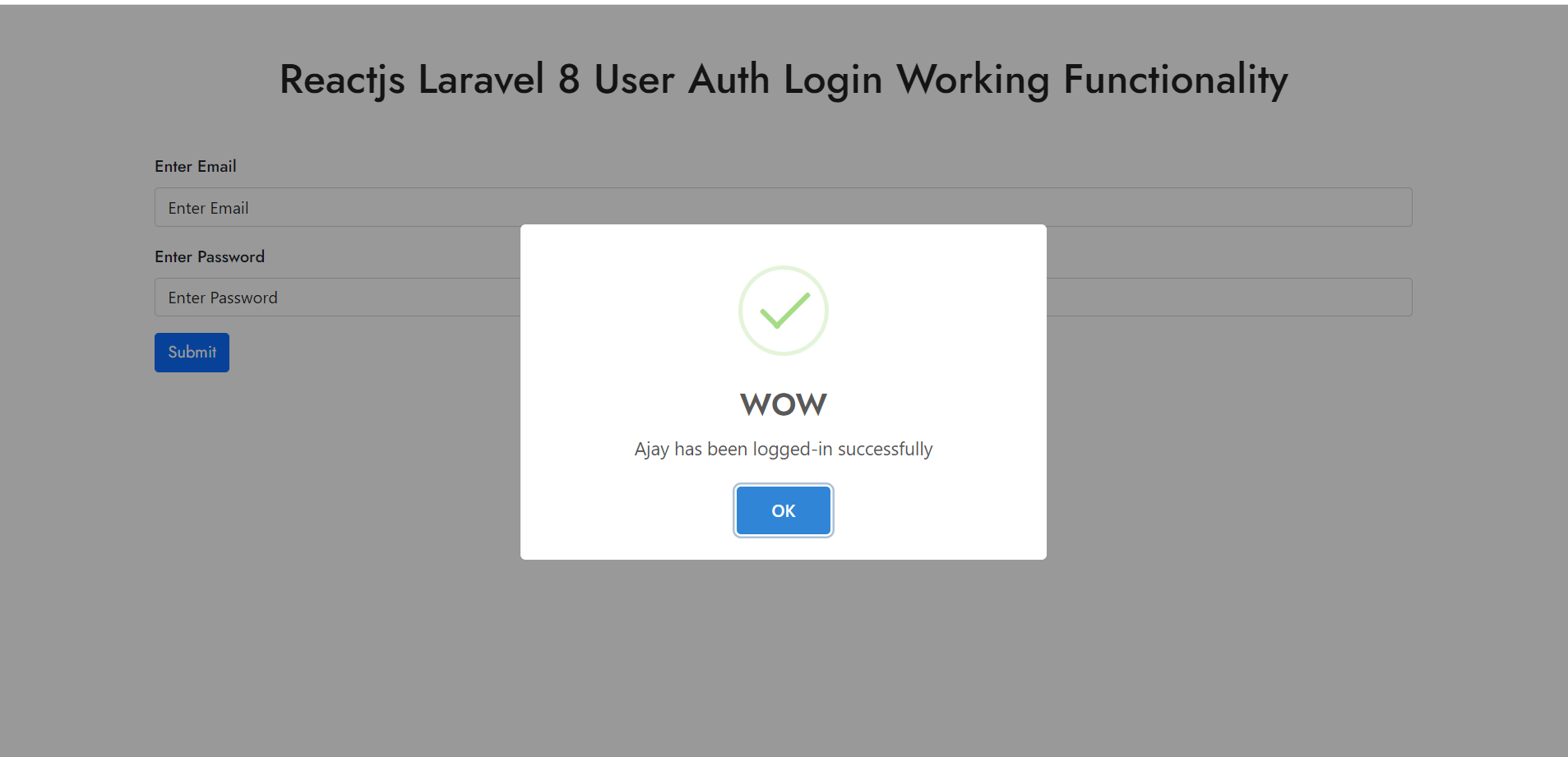Hello guy’s welcome back to my blog. Today in this blog post, I am going to tell you, Reactjs Laravel 8 AUTH User Login Working Example.
Guy’s in this post we will do below things:
- Reactjs Laravel 8 user login functionality.
- Reactjs add sweetalert2 popup for success and error messages which will come from laravel 8 backend.
- React js Bootstrap 5 working.
Very first please check the working video:
Guy’s for setup laravel 8 auth user login and register backend process please check below links and after it process with this post:
- Laravel8 create user login register pages tutorial.
- Laravel8 create database settings to save user data in database.
- Reactjs Laravel8 auth user registration


Friends now I proceed onwards and here is the working code snippet and please use this carefully to avoid the mistakes:
1. Firstly friends we need fresh reactjs setup and for that we need to run below commands into our terminal and also w should have latest node version installed on our system:
npx create-react-app reactlaravel cd reactlaravel npm start // run the project
2. Now you need to run below commands to get axios, bootstrap and sweetalert module to make reactjs app looks good:
npm install sweetalert2-react npm install bootstrap --save npm install axios --save npm start
3. Finally friends we need to add below code into our src/App.js file to get final output on web browser:
import React from 'react';
import './App.css';
//bootstrap
import 'bootstrap/dist/css/bootstrap.min.css';
//Include Sweetalert
import Swal from 'sweetalert2'
//axios for api request
import axios from 'axios';
class App extends React.Component {
constructor(props)
{
super(props);
this.addFormData = this.addFormData.bind(this);
}
//Form Submission
addFormData(evt)
{
evt.preventDefault();
const fd = new FormData();
fd.append('email', this.refs.myEmail.value);
fd.append('password', this.refs.password.value);
//call api
axios.post('http://127.0.0.1:8000/api/login', fd
).then(res=>
{
//Success alert
if(res["data"]["status"] === "error")
{
Swal.fire({
title: 'OPPS',
text: "Error,
type: 'warning',
});
}
else
{
Swal.fire({
title: 'WOW',
text: "You have been logged-in successfully",
type: 'success',
});
}
this.myFormRef.reset();
}
);
}
render() {
return (
<div className="maincontainer">
<div className="container p-5">
<h1 className="text-center mb-5">Jassa therichpost</h1>
<form ref={(el) => this.myFormRef = el}>
<div class="mb-3">
<label for="exampleFormControlInput2" class="form-label">Enter Email</label>
<input type="email" name="email" class="form-control" id="exampleInputEmail1" aria-describedby="emailHelp" placeholder="Enter Email" ref="myEmail" />
</div>
<div class="mb-3">
<label for="exampleFormControlInput3" class="form-label">Enter Password</label>
<input type="password" name="password" class="form-control" id="exampleInputPass1" aria-describedby="passHelp" placeholder="Enter Password" ref="password" />
</div>
<button type="submit" className="btn btn-primary" onClick={this.addFormData}>Submit</button>
</form>
</div>
</div>
)
};
}
export default App;
Laravel 8 api and controller functions:
1. Now we need to create new folder ‘API’ inside app/Http/Controllers folder and after that, we need to create AuthController.php file inside app/Http/Controllers/API folder and below code into it:
<?php
namespace App\Http\Controllers\API;
use Illuminate\Http\Request;
use App\Http\Controllers\Controller;
use Illuminate\Support\Facades\Auth;
use App\Models\User;
use Validator;
use Illuminate\Support\Str;
class AuthController extends Controller
{
private $apiToken;
public function __construct()
{
$this->apiToken = uniqid(base64_encode(Str::random(40)));
}
/**
*
* @return \Illuminate\Http\Response
*/
public function login(Request $request){
//User check
if(Auth::attempt(['email' => $request->email, 'password' => $request->password])){
$user = Auth::user();
//Setting login response
$success['token'] = $this->apiToken;
$success['name'] = $user->name;
return response()->json([
'status' => 'success',
'data' => $success
]);
} else {
return response()->json([
'status' => 'error',
'data' => 'Unauthorized Access'
]);
}
}
}
2. Now we need to add below code inside routes/api.php:
...
Route::post('login', [App\Http\Controllers\API\AuthController::class, 'login'])->name('login');
Now guy’s we are done. In next post we will do Reactjs Laravel 8 ecommerce site.
Guy’s if you have any kind of query then please feel free and comment below.
Jassa
Thanks

Leave a Reply
You must be logged in to post a comment.